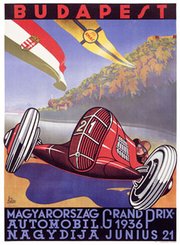Hungarian Grand Prix
|
|
Template:F1 race The first Hungarian Grand Prix was held on June 21, 1936 over a 3.1-mile track laid out in a park near the center of Budapest. The Mercedes-Benz, Auto Union, and Ferrari teams all sent three cars and the event drew a very large crowd. However, politics and the ensuing war meant the end of Grand Prix motor racing in the country for fifty years.
A major coup by Bernie Ecclestone, the 1986 Hungarian Grand Prix was the first Formula One race to take place behind the Iron Curtain. Taking place at the twisty Hungaroring near Budapest, the race has been a mainstay of the racing calendar. Run in the heat of a central European summer, it also holds the distinction of being the only current Grand Prix venue that has never seen a wet race. The first Grand Prix saw 200,000 people spectating, although tickets cost several time the average Hungarian's wage at the time. Today, the support is still very enthusiastic, particularly from Finns, who travel down in the absence of a Scandinavian Grand Prix.
Due to the nature of the track, narrow, twisty and often dusty from under-use, the Hungarian Grand Prix is associated with processional races, with crocodiles of sometimes six cars following one another, unable to pass. Thierry Boutsen demonstrated this perfectly in 1990, keeping his slower Williams car in front of champion-elect Ayrton Senna, unable to find a way by. The secret to a winning performance at Hungaroring is pit strategy, best demonstrated best in the 1998 GP, where Michael Schumacher's Ferrari team changed his strategy mid-race before Schumacher put in one of his finest drives to build up a winning margin after all the stops had been made. Passing is a rarity here, although the 1989 race saw a famously bullish performance from Nigel Mansell in the Ferrari, who started from 12th on the grid and passed car after car, finally taking the lead in splendid opportunist style when Ayrton Senna was baulked by a slower runner. The circuit was modified slightly in 2003 in an attempt to allow more passing.
Other notable occasions in Budapest include first Grand Prix wins for Damon Hill (in 1993) and Fernando Alonso, the first Grand Prix winner from Spain, who also became the youngest ever driver to win a GP in 2003. Also noteworthy is Damon Hill's stunning near win in the unfancied Arrows-Yamaha in 1997, when his car lost drive on the last lap causing him to coast in in second place. In 2001, Michael Schumacher equalled Alain Prost's then record 51 Grand Prix wins at the Hungaroring, in the drive which also secured his 4th World Title.
Winners of the Hungarian Grands Prix
| Races in the Formula One championship: |
| 2005 championship Grand Prix events: Australian |
Malaysian |
Bahrain |
San Marino |
Spanish |
Monaco |
European |
Canadian |
U.S. |
| Past championship Grand Prix events: Argentine |
Austrian |
Czechoslovakian |
Dutch |
Indy 500 |
Las Vegas |
Luxembourg |
Mexican |
Morocco |

